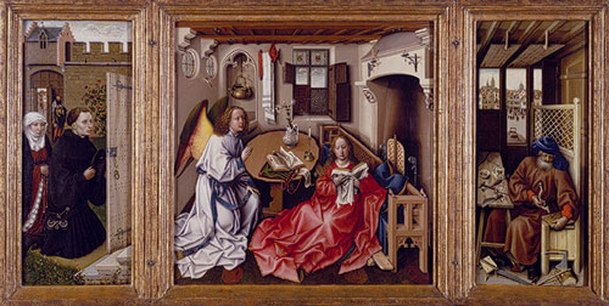When I was a wee little artist, I traveled to New York City with some students from my high school and our art teacher. We went to all museums, as expected, and saw all KINDS of impressive and beautiful and truly breathtaking art. One piece that really caught my attention, especially after a conversation with a gallery attendant, was the Annunciation Triptych, from the workshop of Robert Campin. This painting is a beautiful example of the use of symbols and iconography to tell a second story in art.
The middle panel is the the panel I focus on every time I look at this image, which I suppose is the point, but there are many small, almost insignificant details that hint towards the religious scene taking place: when Gabriel tells Mary she will be the mother of Jesus. We can see the moment Gabriel lands, putting out the candle on the table. Mary isn't even aware he is in the room yet. Looking closely at the image, one can see a lily and a laver, both symbolizing Mary's purity in the divine birth of Christ. Looking towards the left windows, there is a tiny little baby Jesus flying down with a cross, signifying the incarnation. While the candle has gone out because of Gabriel's arrival, it also signifies the moment God becomes man, another symbol of the Incarnation.
There are many other small indicators of Mary and Joseph's socio-economic status, along with indicators of who painted the image and where it was created. While the image can be interpreted and appreciated without the understanding of the smaller symbols, they would have been extremely important to contemporaries, and remain important today in showing us the importance of symbolism and imagery.
The image and information was taken from The Metropolitan Museum of Art's website.
The middle panel is the the panel I focus on every time I look at this image, which I suppose is the point, but there are many small, almost insignificant details that hint towards the religious scene taking place: when Gabriel tells Mary she will be the mother of Jesus. We can see the moment Gabriel lands, putting out the candle on the table. Mary isn't even aware he is in the room yet. Looking closely at the image, one can see a lily and a laver, both symbolizing Mary's purity in the divine birth of Christ. Looking towards the left windows, there is a tiny little baby Jesus flying down with a cross, signifying the incarnation. While the candle has gone out because of Gabriel's arrival, it also signifies the moment God becomes man, another symbol of the Incarnation.
There are many other small indicators of Mary and Joseph's socio-economic status, along with indicators of who painted the image and where it was created. While the image can be interpreted and appreciated without the understanding of the smaller symbols, they would have been extremely important to contemporaries, and remain important today in showing us the importance of symbolism and imagery.
The image and information was taken from The Metropolitan Museum of Art's website.

 RSS Feed
RSS Feed